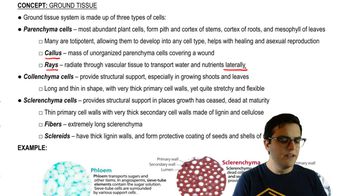Table of contents
- 1. Introduction to Biology2h 42m
- 2. Chemistry3h 40m
- 3. Water1h 26m
- 4. Biomolecules2h 23m
- 5. Cell Components2h 26m
- 6. The Membrane2h 31m
- 7. Energy and Metabolism2h 0m
- 8. Respiration2h 40m
- 9. Photosynthesis2h 49m
- 10. Cell Signaling59m
- 11. Cell Division2h 47m
- 12. Meiosis2h 0m
- 13. Mendelian Genetics4h 44m
- Introduction to Mendel's Experiments7m
- Genotype vs. Phenotype17m
- Punnett Squares13m
- Mendel's Experiments26m
- Mendel's Laws18m
- Monohybrid Crosses19m
- Test Crosses14m
- Dihybrid Crosses20m
- Punnett Square Probability26m
- Incomplete Dominance vs. Codominance20m
- Epistasis7m
- Non-Mendelian Genetics12m
- Pedigrees6m
- Autosomal Inheritance21m
- Sex-Linked Inheritance43m
- X-Inactivation9m
- 14. DNA Synthesis2h 27m
- 15. Gene Expression3h 20m
- 16. Regulation of Expression3h 31m
- Introduction to Regulation of Gene Expression13m
- Prokaryotic Gene Regulation via Operons27m
- The Lac Operon21m
- Glucose's Impact on Lac Operon25m
- The Trp Operon20m
- Review of the Lac Operon & Trp Operon11m
- Introduction to Eukaryotic Gene Regulation9m
- Eukaryotic Chromatin Modifications16m
- Eukaryotic Transcriptional Control22m
- Eukaryotic Post-Transcriptional Regulation28m
- Eukaryotic Post-Translational Regulation13m
- 17. Viruses37m
- 18. Biotechnology2h 58m
- 19. Genomics17m
- 20. Development1h 5m
- 21. Evolution3h 1m
- 22. Evolution of Populations3h 52m
- 23. Speciation1h 37m
- 24. History of Life on Earth2h 6m
- 25. Phylogeny2h 31m
- 26. Prokaryotes4h 59m
- 27. Protists1h 12m
- 28. Plants1h 22m
- 29. Fungi36m
- 30. Overview of Animals34m
- 31. Invertebrates1h 2m
- 32. Vertebrates50m
- 33. Plant Anatomy1h 3m
- 34. Vascular Plant Transport1h 2m
- 35. Soil37m
- 36. Plant Reproduction47m
- 37. Plant Sensation and Response1h 9m
- 38. Animal Form and Function1h 19m
- 39. Digestive System1h 10m
- 40. Circulatory System1h 57m
- 41. Immune System1h 12m
- 42. Osmoregulation and Excretion50m
- 43. Endocrine System1h 4m
- 44. Animal Reproduction1h 2m
- 45. Nervous System1h 55m
- 46. Sensory Systems46m
- 47. Muscle Systems23m
- 48. Ecology3h 11m
- Introduction to Ecology20m
- Biogeography14m
- Earth's Climate Patterns50m
- Introduction to Terrestrial Biomes10m
- Terrestrial Biomes: Near Equator13m
- Terrestrial Biomes: Temperate Regions10m
- Terrestrial Biomes: Northern Regions15m
- Introduction to Aquatic Biomes27m
- Freshwater Aquatic Biomes14m
- Marine Aquatic Biomes13m
- 49. Animal Behavior28m
- 50. Population Ecology3h 41m
- Introduction to Population Ecology28m
- Population Sampling Methods23m
- Life History12m
- Population Demography17m
- Factors Limiting Population Growth14m
- Introduction to Population Growth Models22m
- Linear Population Growth6m
- Exponential Population Growth29m
- Logistic Population Growth32m
- r/K Selection10m
- The Human Population22m
- 51. Community Ecology2h 46m
- Introduction to Community Ecology2m
- Introduction to Community Interactions9m
- Community Interactions: Competition (-/-)38m
- Community Interactions: Exploitation (+/-)23m
- Community Interactions: Mutualism (+/+) & Commensalism (+/0)9m
- Community Structure35m
- Community Dynamics26m
- Geographic Impact on Communities21m
- 52. Ecosystems2h 36m
- 53. Conservation Biology24m
33. Plant Anatomy
Tissues
Problem 7`
Textbook Question
Which of the following would not be seen in a cross section through the woody part of a root?
a. Sclerenchyma cells
b. Parenchyma cells
c. Sieve-tube elements
d. Root hairs
 Verified step by step guidance
Verified step by step guidance1
Understand the structure of a woody root: Woody roots are primarily composed of secondary xylem and secondary phloem, which are produced by the vascular cambium.
Identify the types of cells typically found in woody roots: Woody roots contain sclerenchyma cells, parenchyma cells, and various elements of the vascular system such as xylem and phloem cells.
Recognize the function and location of sieve-tube elements: Sieve-tube elements are part of the phloem tissue, responsible for transporting nutrients throughout the plant. They are typically found in the vascular system.
Consider the role and location of root hairs: Root hairs are extensions of epidermal cells that increase surface area for absorption. They are found on the outer surface of roots, not within the woody part.
Determine which option is not typically found in a cross section of the woody part of a root: Since root hairs are located on the outer surface and not within the woody part, they would not be seen in a cross section through the woody part of a root.
 Verified video answer for a similar problem:
Verified video answer for a similar problem:This video solution was recommended by our tutors as helpful for the problem above
Video duration:
3mPlay a video:
Was this helpful?
Key Concepts
Here are the essential concepts you must grasp in order to answer the question correctly.
Woody Root Structure
The woody part of a root primarily consists of xylem and phloem tissues, which are responsible for water and nutrient transport. Xylem includes vessels and tracheids, while phloem contains sieve-tube elements and companion cells. Understanding the composition of these tissues is crucial for identifying what structures are present in a cross-section of a woody root.
Recommended video:
Guided course

Root System
Sclerenchyma Cells
Sclerenchyma cells are a type of plant cell known for their thick, lignified walls, providing structural support to the plant. They are commonly found in various parts of the plant, including stems and roots, often associated with vascular tissues. Their presence in woody roots is typical due to their supportive role.
Recommended video:
Guided course

Ground Tissue Cells
Root Hairs
Root hairs are extensions of root epidermal cells that increase the surface area for water and nutrient absorption. They are typically found in the root's non-woody parts, particularly in the region of maturation. In a cross-section of a woody root, root hairs are absent as they are part of the outermost layer, not the internal woody structure.
Recommended video:
Guided course

Root System
Related Videos
Related Practice


















